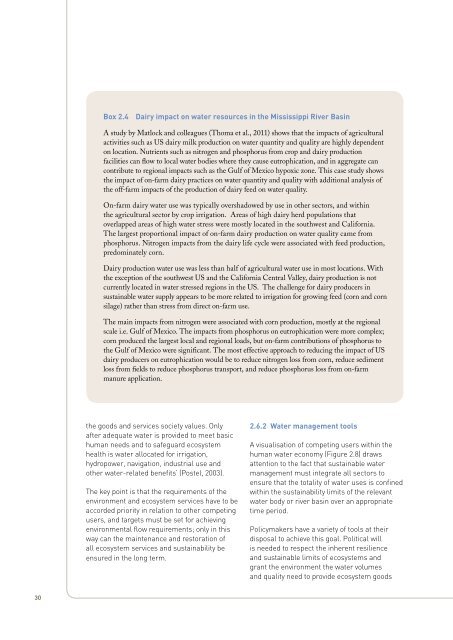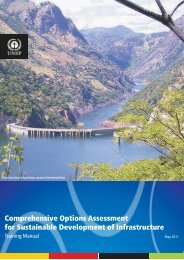MEASURING WATER USE IN A GREEN ECONOMY - UNEP
MEASURING WATER USE IN A GREEN ECONOMY - UNEP
MEASURING WATER USE IN A GREEN ECONOMY - UNEP
You also want an ePaper? Increase the reach of your titles
YUMPU automatically turns print PDFs into web optimized ePapers that Google loves.
Box 2.4 Dairy impact on water resources in the Mississippi River Basin<br />
A study by Matlock and colleagues (Thoma et al., 2011) shows that the impacts of agricultural<br />
activities such as US dairy milk production on water quantity and quality are highly dependent<br />
on location. Nutrients such as nitrogen and phosphorus from crop and dairy production<br />
facilities can flow to local water bodies where they cause eutrophication, and in aggregate can<br />
contribute to regional impacts such as the Gulf of Mexico hypoxic zone. This case study shows<br />
the impact of on-farm dairy practices on water quantity and quality with additional analysis of<br />
the off-farm impacts of the production of dairy feed on water quality.<br />
On-farm dairy water use was typically overshadowed by use in other sectors, and within<br />
the agricultural sector by crop irrigation. Areas of high dairy herd populations that<br />
overlapped areas of high water stress were mostly located in the southwest and California.<br />
The largest proportional impact of on-farm dairy production on water quality came from<br />
phosphorus. Nitrogen impacts from the dairy life cycle were associated with feed production,<br />
predominately corn.<br />
Dairy production water use was less than half of agricultural water use in most locations. With<br />
the exception of the southwest US and the California Central Valley, dairy production is not<br />
currently located in water stressed regions in the US. The challenge for dairy producers in<br />
sustainable water supply appears to be more related to irrigation for growing feed (corn and corn<br />
silage) rather than stress from direct on-farm use.<br />
The main impacts from nitrogen were associated with corn production, mostly at the regional<br />
scale i.e. Gulf of Mexico. The impacts from phosphorus on eutrophication were more complex;<br />
corn produced the largest local and regional loads, but on-farm contributions of phosphorus to<br />
the Gulf of Mexico were significant. The most effective approach to reducing the impact of US<br />
dairy producers on eutrophication would be to reduce nitrogen loss from corn, reduce sediment<br />
loss from fields to reduce phosphorus transport, and reduce phosphorus loss from on-farm<br />
manure application.<br />
the goods and services society values. Only<br />
after adequate water is provided to meet basic<br />
human needs and to safeguard ecosystem<br />
health is water allocated for irrigation,<br />
hydropower, navigation, industrial use and<br />
other water-related benefits’ (Postel, 2003).<br />
The key point is that the requirements of the<br />
environment and ecosystem services have to be<br />
accorded priority in relation to other competing<br />
users, and targets must be set for achieving<br />
environmental flow requirements; only in this<br />
way can the maintenance and restoration of<br />
all ecosystem services and sustainability be<br />
ensured in the long term.<br />
2.6.2 Water management tools<br />
A visualisation of competing users within the<br />
human water economy (Figure 2.8) draws<br />
attention to the fact that sustainable water<br />
management must integrate all sectors to<br />
ensure that the totality of water uses is confined<br />
within the sustainability limits of the relevant<br />
water body or river basin over an appropriate<br />
time period.<br />
Policymakers have a variety of tools at their<br />
disposal to achieve this goal. Political will<br />
is needed to respect the inherent resilience<br />
and sustainable limits of ecosystems and<br />
grant the environment the water volumes<br />
and quality need to provide ecosystem goods<br />
30

















